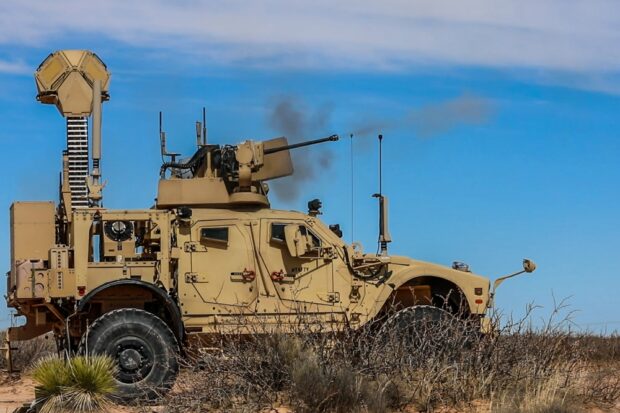Russia is producing more than 100 Iranian-designed drones a week for its ongoing war in Ukraine, a top U.S. military commander told Congress, providing a fresh example of how small drones are changing modern warfare across the globe.
U.S. Central Command boss Army Gen. Michael “Erik” Kurilla said that Russia initially asked Iran for one-way attack drones, specifically the Shahed-136. To boost the supply, Iran helped Russia build a factory in Russian territory.
“The relationship between Iran and Russia, that really started when they asked for them to provide the one-way attack UASs,” Kurrila told the House Armed Services Committee March 21. “They started providing complete systems, and they built an actual factory in Russia, and those same Shahed-136—a very capable system—are now going at a rate of over 100 a week from Russia into Ukraine.”
The Shahad-136 has added to the threat to U.S. partners and potentially American forces themselves. It was just one of an array of systems featured in combatant commanders’ testimony to Congress in the past few weeks as they discussed threats from Europe, Asia, and the Middle East.
To try to counter the growing drone threat, Ukraine has employed new systems, such as acoustic detection networks made up of thousands of cell phones, according to Gen. James B. Hecker, the head of U.S. Air Forces in Europe-Air Forces Africa. Ukraine and Russia are locked in a battle of electronic warfare to try to counter the drones effectively and without having to use expensive air defense weapons, according to analysts.
In the Middle East, where U.S. troops have been attacked by drones and rockets in Iraq, Syria, and Jordan—where three Soldiers were killed in an attack—American forces are using a range of defensive systems, including short-range Coyote air defense systems and even netting to protect bases.
One novel system that has been deployed is a 50-kilowatt high-energy laser air defense system. Kurilla said three of those experimental systems mounted on armored Stryker vehicles have been sent to Iraq.
The Directed Energy Maneuver Short-Range Air Defense, or DE M-SHORAD, is a short-range system theoretically capable of tackling small drones and rockets. Breaking Defense first reported the deployment of the developmental Army system to the Middle East, which complements the deployment of Patriot anti-missile systems and the THAAD anti-missile system that have also been sent to deal with more sophisticated threats.
“We are experimenting with those, and the best and most effective way to use those is to help them learn from that to be able to make better systems,” Kurilla said.
“Directed energy is not the panacea,” Kurilla added, noting that the systems are costly. “It will be part of a layered defense. We have to be able to get further out with it to be able to bring down these systems when it’s only costing a dollar a shot, minus acquisition, to be able to do that. But I would tell you what’s worse than shooting a $1 million missile at a $20,000 drone is that $20,000 drone hitting a $2 billion ship with 300 sailors on it.”
The ongoing clashes with Houthi drones and missiles in the Red Sea have dramatized that point. The U.S. has deployed warships and an aircraft carrier to the region. The U.S. has had to use F-18 fighters firing expensive air-to-air missiles to knock down the drones. Navy AEGIS-equipped surface vessels are firing the Standard Missile 2 (SM-2) at drones, effective air defense weapons, but ones that cost roughly $2 million a piece.
CENTCOM understands how useful cheap drones can be. Air Forces Central is trying to put its own low-cost, experimental drones into operational use with its Task Force 99 unit.
The drone threat is a problem in Asia, too.
“What we do have to do is move forward on our directed energy path to be able to get on the right side of this cost curve,”
Adm. John C. Aquilino, the head of U.S. Indo-Pacific Command, told the House Armed Services Committee on March 20.
Drones are not just a problem in faraway locations. In the U.S., mysterious drone swarms have appeared near Joint Base Langley-Eustis, Va, as first reported by The War Zone, posing a surprising dilemma for Gen. Gregory Guillot, the new head of NORAD and U.S. Northern Command. Guillot, the former deputy commander of CENTCOM, launched a 90-day assessment of homeland defense upon taking command in February. Guillot said the drone incursions at Joint Base Langley-Eustis were the “centerpiece” of that assessment.
“To tell the truth, the counter-UAS mission has dominated that so far in the first month,” Guillot told the Senate Armed Services Committee on March 14. “Of course, I knew it was an issue coming from another combatant command where we faced that threat in a very different way because of the environment. But I wasn’t prepared for the number of incursions that I see.”
There are alternatives to relying on defenses alone to take down drones, however.
“There are all kinds of point defense solutions,” Caitlin Lee, the director of the acquisition and technology policy program at the RAND Corporation, told Air & Space Forces Magazine. “I think there’s a broader complementary approach. There are state backers, entire networks of logistics supply chains, and even training that are backing the militants and violent extremist organizations that are using these drone capabilities and other low-cost munitions. And so I think there’s a real need to get left of launch on the drone fight.”
Added Lee:
“We got really good at hunting down IED networks. Well, drones are flying IEDs.”
Photo:The 44th Infantry Brigade Combat Team Base Defense Operations Center crews observed a mobile-low, slow, small, unmanned aircraft integrated defeat system live-fire to instill confidence in kinetic systems capable of shooting down one-way UAS attacks during pre-deployment Green Sands training Continental United States at McGregor Range Complex, New Mexico March 4, 2024.U.S. Army photo by Sgt. Raquel Birk
Source: Air and Space Forces

